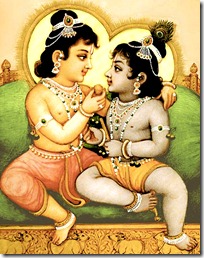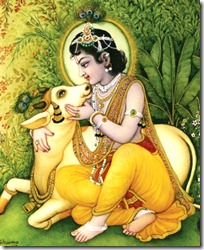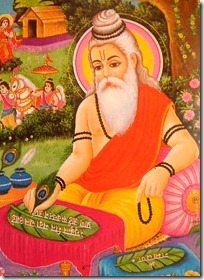 “You refer to everything as ‘Mine, Mine’, but can you tell me who you are or what your real name is? Silently perform religious practices and hear transcendental subject matters to understand everything properly, says Tulsi, or simply chant Shri Rama’s holy name.” (Dohavali, 18) “You refer to everything as ‘Mine, Mine’, but can you tell me who you are or what your real name is? Silently perform religious practices and hear transcendental subject matters to understand everything properly, says Tulsi, or simply chant Shri Rama’s holy name.” (Dohavali, 18)mora mora saba kaham̐ kahisa tū ko kahu nija nāma | kai cupa sādhahi suni samujhi kai tulasī japu rāma || From the very beginning of their lives, children who are watched over carefully by guardians, interested parents, and well-wishing teachers are taught the importance of sharing. Should the child simply go from toy to toy and object to object saying, “Mine, Mine”, their attitude is considered one that needs changing. “Sharing is caring” as they say, so if a youngster can learn the importance of working with others and acquire some level of detachment from sense objects, their maturity into adulthood can accelerate. But the teachings of the Vedas, the ancient scriptures of India, don’t stop there. In addition to learning that toys and objects of enjoyment need to be shared, the individual residing within any form of body must make the most of the opportunity of the human life by understanding who they really are. Unless and until that understanding is present, the selfish mentality will continue in some way or another.  Labeling everything as “Mine” is silly for the child because they are incapable of producing anything on their own. Even the toys in the room that are only played with by the child were originally provided by someone else. It would certainly be silly to have a deep obsession and sense of ownership over something that we didn’t purchase ourselves. Even in the adult years, the importance of sharing tends to get forgotten when the ego expands through personal achievements. Say, for instance, we work very hard at our job and save up enough money to buy something we want. When we purchase the item and bring it home, obviously we will refer to it as “Mine”. But is this mindset accurate? Did we create the parts that went into the construction of our cherished object? Where were these parts before our time on earth and where will they go after we finish our time here? Labeling everything as “Mine” is silly for the child because they are incapable of producing anything on their own. Even the toys in the room that are only played with by the child were originally provided by someone else. It would certainly be silly to have a deep obsession and sense of ownership over something that we didn’t purchase ourselves. Even in the adult years, the importance of sharing tends to get forgotten when the ego expands through personal achievements. Say, for instance, we work very hard at our job and save up enough money to buy something we want. When we purchase the item and bring it home, obviously we will refer to it as “Mine”. But is this mindset accurate? Did we create the parts that went into the construction of our cherished object? Where were these parts before our time on earth and where will they go after we finish our time here?The Vedic teachings stipulate that Lord Krishna, the Supreme Personality of Godhead, is the original owner of everything, including every manifestation of matter. The spirit soul within the body is the identifying aspect, a spark of energy that never dissipates in intensity or potency for action. The objects that can be perceived through the senses are technically on loan from God for our enjoyment. Just as we don’t really own our home or car if we still owe money to the bank that loaned us the money to make the purchase, the Supreme Lord maintains His ownership over matter for all of eternity. We may borrow and use the elements found in material nature, but there is never a transfer of ownership. The main reason for this policy of repeated lending is that man cannot remain in the same body perpetually. There will come a time when the current outer covering of the soul gets renounced, thus leaving the resultant elements again up for auction to whoever needs to use them. Sometimes the vacated body is burned to ashes and thus mixed in with other outside elements. When the body is buried, it gradually morphs into the earth. In the worst case, the corpse becomes food for a crow. In this way we see that the temporary ownership transfers every minute, with new lessees coming and going. Therefore it would be silly to refer to anything as ultimately belonging to us.  The root cause of the flawed “I” and “Mine” mentalities is ignorance of the self. This is the point addressed by Goswami Tulsidasin the above referenced verse from the Dohavali. Any conditioned individual, one who is ignorant of God’s supremacy and original claim of ownership, will be deluded by the “Mine” mentality, labeling everything as belonging to them. The harm in thinking this way is that it doesn’t lead to any tangible benefit. One who knows their dharma, or occupational duty based on their constitutional position, can take the necessary steps towards reaching the final destination, param gatim. On the other hand, the ignorant will never head in the right direction. Say, for example, one is playing the game of American football. If they are playing on the defensive side of the ball, should they happen to intercept a pass or pick up a fumble, the objective is to run with the ball towards the endzone being defended by the offensive team. But one who doesn’t know the objective of the game will be prone to running the wrong way. Running in the opposite direction only helps the opponents; thus it goes against the characteristic condition, or dharma, of the player and his team. The root cause of the flawed “I” and “Mine” mentalities is ignorance of the self. This is the point addressed by Goswami Tulsidasin the above referenced verse from the Dohavali. Any conditioned individual, one who is ignorant of God’s supremacy and original claim of ownership, will be deluded by the “Mine” mentality, labeling everything as belonging to them. The harm in thinking this way is that it doesn’t lead to any tangible benefit. One who knows their dharma, or occupational duty based on their constitutional position, can take the necessary steps towards reaching the final destination, param gatim. On the other hand, the ignorant will never head in the right direction. Say, for example, one is playing the game of American football. If they are playing on the defensive side of the ball, should they happen to intercept a pass or pick up a fumble, the objective is to run with the ball towards the endzone being defended by the offensive team. But one who doesn’t know the objective of the game will be prone to running the wrong way. Running in the opposite direction only helps the opponents; thus it goes against the characteristic condition, or dharma, of the player and his team.If identification remains flawed to the point that sense objects are deemed ultimate possessions to be enjoyed in the absence of the company of the Supreme Spirit, the actual owner of the body goes the wrong way in life, the direction opposite from that which leads to liberation. The freeing from the cycle of birth and death is important not only because of the release granted from the effects of material nature but also because of the beauty of the future destination, the correct “endzone”. From Vedic information kindly passed on by past humble devotees, who were nice enough to note down their observations and careful analysis in wonderful books which are now considered scripture, we learn that the soul’s eternal position is that of servant of the Supreme Lord. God was born to be served and we were born to voluntarily take up His service. Obviously there is no birth for either entity, but the principles still apply. We have no way of understanding something that has no beginning and no end, or sanatana, therefore terms like “original” and “constitutional” are invoked. The first challenge is how to accept the fact that the soul is meant to be a servant of God. Who is God anyway, and how do we know that He is worthy of our worship? Also, how do we engage in this service? There are a few options available to the soul deluded by the “Mine” mentality. As the soul is eternally the same in constitution, anyone who can realize its presence can slowly but surely understand the blissful nature of the sublime engagement of devotional service, or bhakti-yoga. As the soul resides within the heart, the more the sincere spiritualist can minimize the effects of the gross senses, the greater the likelihood of developing the proper identity. To this end, there are many processes, rituals, regulations, restrictions and recommended practices, all of which form the bases of the many different religions in existence. Though there are so many theistic traditions, provided that the proper identification is ultimately realized, any system of spirituality can be accepted.  In the absence of the proper identification, no amount of spiritual healing can alter the flawed mindset of false proprietorship. For instance, if a spiritual discipline calls for regular worship of God but then also sanctions and even recommends the slaughter of innocent animals, there cannot be any tangible knowledge acquired. Why is this? The soul is the source of identity not only within the human body but also in every other life form. Anything we consider life, those outward objects which seemingly function on their own, has a spirit soul inside. There is no need to unnecessarily kill any other being. The practice of mass animal slaughter simply to satisfy the taste buds is one based on gross ignorance of the eternal nature of spirit and its acrobatic abilities to jump from one body type to another through what is commonly referred to as reincarnation. In the absence of the proper identification, no amount of spiritual healing can alter the flawed mindset of false proprietorship. For instance, if a spiritual discipline calls for regular worship of God but then also sanctions and even recommends the slaughter of innocent animals, there cannot be any tangible knowledge acquired. Why is this? The soul is the source of identity not only within the human body but also in every other life form. Anything we consider life, those outward objects which seemingly function on their own, has a spirit soul inside. There is no need to unnecessarily kill any other being. The practice of mass animal slaughter simply to satisfy the taste buds is one based on gross ignorance of the eternal nature of spirit and its acrobatic abilities to jump from one body type to another through what is commonly referred to as reincarnation.Similarly, those who take to worshiping a Supreme Being only to receive benedictions in the form of material opulence and the alleviation of distress also fail to understand the true nature of spirit. The individual soul is the identifiable aspect in all forms of life, and with that identity comes a natural activity, an engagement which is the primary source of pleasure. If the mind continues to rely on material objects, those things which the individual has no rightful claim to, as the ultimate sources of pleasure, then the true properties of spirit remain a mystery. The soul must have an eternal engagement, and in this business there must be a beneficiary of activity. Only when the object of service is Krishna, or God, has the true identity of the soul been understood.  Based on the difficulty of understanding God and the soul through strict religious practice - which can include quiet meditation, adherence to regulative principles, and hearing transcendental topics – the individual conditioned soul would be better suited taking directly to a version of its eternal engagement. This is the recommendation made by Tulsidas. He says that the soul deluded by the “Mine” mentality should either remain quiet and perform sadhana, or regulative religious activity, or simply chant the name of Rama. Tulsidas prefers the latter option, as it is more potent and a direct manifestation of bhakti. Based on the difficulty of understanding God and the soul through strict religious practice - which can include quiet meditation, adherence to regulative principles, and hearing transcendental topics – the individual conditioned soul would be better suited taking directly to a version of its eternal engagement. This is the recommendation made by Tulsidas. He says that the soul deluded by the “Mine” mentality should either remain quiet and perform sadhana, or regulative religious activity, or simply chant the name of Rama. Tulsidas prefers the latter option, as it is more potent and a direct manifestation of bhakti.Krishna is the name for God describing His all-attractiveness, and Rama describes His ability to provide transcendental pleasure. Depending on which Vedic tradition you follow, you will consider Krishna the more potent and original form of Godhead or you will believe in Lord Rama and no one else. Since they are the same entity, there is really no distinction between the differing viewpoints. The Supreme Lord is one from whom come many, including countless non-different personal expansions. The benefit of chantingRama’s name is that the Supreme Lord is identified first. From this comes cognizance of His brilliance, attractiveness, original claim of ownership on every property, status as the ultimate enjoyer, and fixed position as the best friend of every living entity. “We get all this information simply from chanting?” Yes. The holy name and the person being addressed are the same. This is what it means to be Absolute. We can call out the name of any ordinary object, but that doesn’t mean it will automatically appear before us. Such is not the case with Bhagavan, God who possesses every attribute of opulence simultaneously and to the fullest degree. Simply calling out His name is enough to reawaken the supreme wisdom already resting within the heart. The hidden secret is that we are already aware of the Supreme Lord’s capabilities and position. We already understand our true identity and the supremacy of the bhakti process. But in the conditioned state, when the material elements surround the otherwise pure soul, the torchlight of knowledge, which requires no external source of energy, gets covered up. We may put a shade over a lamp and reduce the intensity of its visible light, but this doesn’t mean that the lamp stops shining. Indeed, the lamp itself is unaffected; just the outward perception has changed. Similarly, even the strongest material covering of ignorance cannot have any effect on the properties of the soul.  Why does chanting work better than the regulative processes of religion? Why is chanting Rama’s name superior to sitting quietly and hearing? The key distinction is in the identity of the beneficiary. Under any model besides bhakti, the enjoyer remains the individual. And since the perceived identity of the enjoyer in these models is flawed, the results that come from the practices remain inferior. In bhakti the only enjoyer is Rama. Even devotees who don’t know who or what they are chanting about receive the greatest benefit. The motivations remain pure in bhakti, as it is impossible to regularly chant, “Hare Krishna Hare Krishna, Krishna Krishna, Hare Hare, Hare Rama Hare Rama, Rama Rama, Hare Hare”, and maintain the possessive mentality for long. Valmiki Muni was a dacoit in his youth, but just by hearing the name of Rama from regularly chanting the reverse sounding word, “mara”, he was able to become transcendentally enlightened. The thief suffers from the worst case of the flawed possessive mentality. If even a robber can turn into a devotee with a perfect understanding of the self, just imagine what can happen for those who are sincerely interested in spiritual life from the beginning. Why does chanting work better than the regulative processes of religion? Why is chanting Rama’s name superior to sitting quietly and hearing? The key distinction is in the identity of the beneficiary. Under any model besides bhakti, the enjoyer remains the individual. And since the perceived identity of the enjoyer in these models is flawed, the results that come from the practices remain inferior. In bhakti the only enjoyer is Rama. Even devotees who don’t know who or what they are chanting about receive the greatest benefit. The motivations remain pure in bhakti, as it is impossible to regularly chant, “Hare Krishna Hare Krishna, Krishna Krishna, Hare Hare, Hare Rama Hare Rama, Rama Rama, Hare Hare”, and maintain the possessive mentality for long. Valmiki Muni was a dacoit in his youth, but just by hearing the name of Rama from regularly chanting the reverse sounding word, “mara”, he was able to become transcendentally enlightened. The thief suffers from the worst case of the flawed possessive mentality. If even a robber can turn into a devotee with a perfect understanding of the self, just imagine what can happen for those who are sincerely interested in spiritual life from the beginning.The holy name is the cure for all ailments and delusions. Those who are wise enough to follow the kind prescriptions offered by Tulsidas will soon develop the only purified form of possessiveness, that of identifying God as theirs. While taking material objects to be “Mine” is considered harmful, viewing the Supreme Lord as being your only friend and savior is the most wonderful mentality, one that maintains an unbroken link in consciousness with the spiritual world . |
Search This Blog
Thursday, July 7, 2011
Mine Mine
Subscribe to:
Post Comments (Atom)
No comments:
Post a Comment